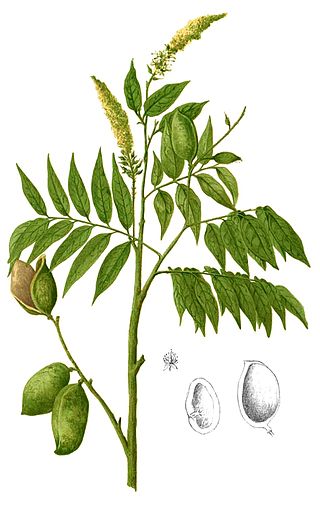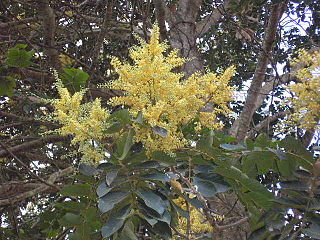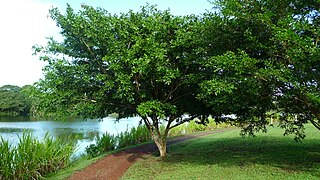
Parkia is a genus of flowering plants in the family Fabaceae. It belongs to the mimosoid clade of the subfamily Caesalpinioideae. Several species are known as African locust bean.

Crudia is a genus of plants in the family Fabaceae.

Dimorphandra is a genus of legume in the family Fabaceae, subfamily Caesalpinioideae. It includes 26 species native to northern South America, ranging from Colombia and Venezuela to Bolivia, Paraguay, and southeastern Brazil.

Macrolobium is a legume genus in the subfamily Detarioideae. It is a tropical genus with about 80 species. Half occur in Brazil, where they are common in the floodplains of the Amazonian Basin. Members of the genus are used as ornamentals and for their wood.

Macrosamanea is a genus of flowering plant in the legume family, Fabaceae. It includes 11 species of trees and shrubs native to northern South America. The genus is most diverse and numerous in the Amazon Basin, extending into the Orinoco basin and the Guianas. Typical habitat is tropical rain forest, mostly riparian and seasonally-flooded. Two species are native to seasonally-inundated wooded grassland (savanna) on sandy soils. The genus belongs to the mimosoid clade of the subfamily Caesalpinioideae.

Ormosia is a genus of legumes. 131 living species, mostly trees or large shrubs, are native to the tropical Americas, from southwestern Mexico to Bolivia and southern Brazil, to southern, southeastern, and eastern Asia, and to New Guinea and Queensland. Most are tropical, while some extend into temperate temperate regions of China. A few species are threatened by habitat destruction, while the Hainan ormosia is probably extinct already.

Swartzia is a genus of flowering plants in the family Fabaceae. It was named in honor of Swedish botanist Olof Swartz and contains about 200 species. Swartzia is restricted in its geographical distribution to the New World Tropics, where it occurs primarily in lowland rainforests, but also in savannas, pre-montane forests, and tropical dry forests. While it can be found throughout the wet lowlands from Mexico and the Caribbean islands to southern Brazil and Bolivia, Swartzia is most abundant and species-rich in Amazonia, where 10–20 species may co-occur at a single site. The species of Swartzia are mostly trees, ranging from small understory treelets to large canopy emergents. Some species, especially in savannas, are mult-stemmed shrubs.

Tachigali is a flowering plant genus in the legume family (Fabaceae). It includes 74 species of trees native to the tropical Americas, ranging from Nicaragua to Bolivia, Paraguay, and southern Brazil. Typical habitats include tropical rain forest, lower montane forest, seasonally-flooded and non-flooded evergreen lowland forest and woodland, gallery and riparian forest, sometimes on white sands, cerrado and other dry woodland, and rocky grassland.

Zygia is a genus of flowering plants in the family Fabaceae. It includes 60 species of tres and shrubs native to the tropical Americas, from Southern Mexico and Cuba to northern Argentina. Typical habitats are tropical forest and coastal zones, generally below 900 meters elevation with a few species extending up to 2800 meters. It belongs to the mimosoid clade of the subfamily Caesalpinioideae.
Naucleopsis is a plant genus in family Moraceae.

Dicymbe is a genus of 20 species of canopy trees in the family Fabaceae, within subfamily Detarioideae. It is found throughout the Guyana Shield region and parts of W Amazonia. Certain species within the genus are strongly associated with ectomycorrhizal fungi.

Duroia is a genus of flowering plants in the family Rubiaceae. The genus is found from Costa Rica to tropical South America.

Schnella is a genus of flowering plants in the legume family, Fabaceae. It belongs to the subfamily Cercidoideae. All of its species are neotropical lianas.
Allantoma is a genus of woody plant in the family Lecythidaceae first described as a genus in 1874. It is native to northwestern South America (Colombia, Venezuela, Peru, northern Brazil.
- Allantoma decandra S.A.Mori, Ya Y.Huang & Prance - Peru, Brazil
- Allantoma integrifolia S.A.Mori - Amazonas State in Brazil
- Allantoma kuhlmannii S.A.Mori - Rondônia State in Brazil
- Allantoma lineata Miers - Amazonas State in Venezuela; Amazonas and Pará States in Brazil
- Allantoma pachyantha S.A.Mori, Ya Y.Huang & Prance - Amazonas State in Brazil
- Allantoma pauciramosa S.A.Mori, Ya Y.Huang & Prance - Amazonas State in Brazil
- Allantoma plurifloraS.A.Mori, Ya Y.Huang & Prance - Colombia
- Allantoma uaupensis S.A.Mori, Ya Y.Huang & Prance - Amazonas State in Brazil

Ferdinandusa is a genus of flowering plants in the family Rubiaceae, native to the American tropics.
Dicranostyles is a genus of flowering plants belonging to the family Convolvulaceae.
Lueheopsis is a genus of flowering plants belonging to the family Malvaceae. It is also in the subfamily of Grewioideae.
Ruizterania is a genus of flowering plants belonging to the family Vochysiaceae.

Zanthoxyloideae is a subfamily of the family Rutaceae.
Wallacea is a genus of flowering plants in the family Ochnaceae. It includes three species of shrubs or trees native to Colombia, Venezuela, and northern Brazil.














